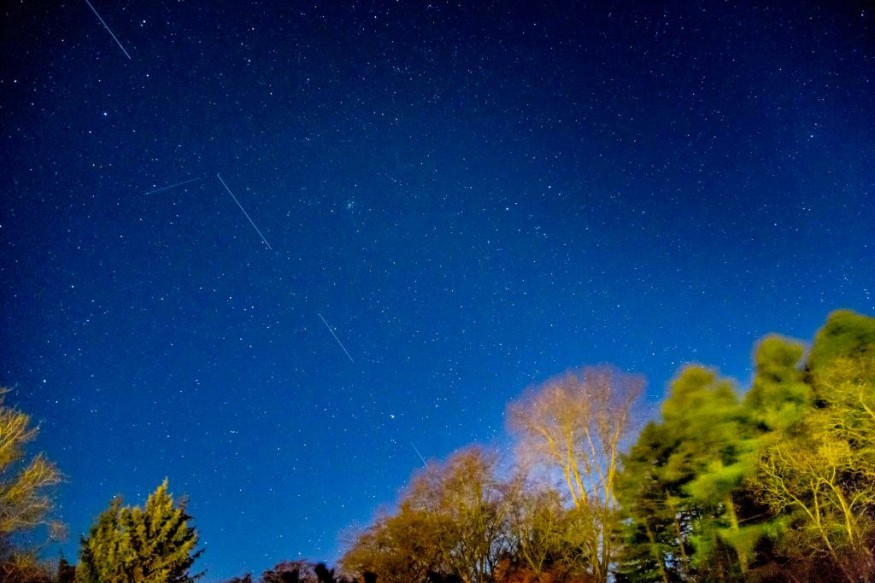Recent research analyzing the influence of SpaceX's Starlink satellites on the night sky said twilight photographs captured by a telescope in California are increasingly showing streaks from satellites.
According to the researchers, the streaks may not be enough to detract from the scientific significance of the photos. However, they may make it more difficult to identify potentially dangerous asteroids.
Researchers detailed their study, "Impact of the SpaceX Starlink Satellites on the Zwicky Transient Facility Survey Observations," in Astrophysical Journal Letters.

SpaceX Starlink Satellites Could Interfere With Observatories
A National Aeronautics and Space Administration (NASA) representative told The Wall Street Journal that satellites could interfere with ground-based observations by increasing the difficulty of distinguishing artificial satellites from natural objects like asteroids and comets.
NASA looks for asteroids and other near-Earth objects in the night sky by watching for points of light that move about the stars.
From November 2019 to September 2021, experts discovered 5,301 streaks from Starlink satellites in photographs obtained by the Zwicky Transient Facility near San Diego. This represents a significant increase from the 0.5 percent of twilight photographs impacted in 2019 to over 20% in 2019.
Researchers said in an Axios report that the Starlink streaks were obvious in twilight photographs, which are critical for detecting potentially harmful asteroids and comets that arrive from the same section of the sky as the Sun.
"We don't expect Starlink satellites to affect non-twilight images, but if the satellite constellation of other companies goes into higher orbits, this could cause problems for non-twilight observations," Przemek Mróz, one of the authors of the new study, said in a statement.
The study's authors predict that every twilight photograph obtained by the ZTF would include a streak from a Starlink satellite if SpaceX manages to build a constellation of 10,000 satellites.
ALSO READ : SpaceX Starlink May Interfere Square Kilometer Array (SKA), Other Large Radio Telescopes
ZTF Science Not Affected
However, Sky&Telescope said some positive news despite the enormous and growing satellite streaks: ZTF science is unaffected.
Because single satellite tracks are weak enough to avoid saturating the ZTF detector, unlike some other observatories, single satellite trails do not overwhelm the ZTF detector.
As a result, the automated pipeline can quickly conceal a satellite flashing over a picture, which already eliminates airplane tracks and the like. While a few pixels (about 0.04 percent of the detector area) are lost, the picture as a whole remains usable.
According to experts, after SpaceX has deployed the whole constellation of 42,000 satellites, every ZTF image obtained during twilight would be tainted by around four satellite streaks.
About 0.2 percent of all pixels would be lost due to this (and so there is a 0.2 percent chance that ZTF may miss a transient during twilight). Even yet, because ZTF re-images the whole sky every two days, whatever they missed would almost certainly be picked up.
One important component of this has been SpaceX's efforts to reduce the brightness of their satellites. Their new "VisorSat" model is 4.6 times fainter than the old model, thanks to a shield that blocks reflected sunlight.
However, it isn't quite at the 7th-magnitude level that a congress of astronomers and business specialists, known as SATCON, has suggested satellites flying at 500 kilometers altitude.
That brightness will saturate ultra-sensitive wide-field detectors, such as the one built at the Vera Rubin Observatory, so the community set that limit.
Most Starlink satellites would now exceed the 7th-magnitude limit, overloading the detector and leaving "ghost trails." If the trails themselves reverberate throughout a picture, there's no straightforward method to conceal them, as ZTF has done.
RELATED ARTICLE : SpaceX Starlink Satellites Now Affect More Twilight Photos, Study Finds
Check out more news and information on Starlink in Science Times.
© 2025 ScienceTimes.com All rights reserved. Do not reproduce without permission. The window to the world of Science Times.











